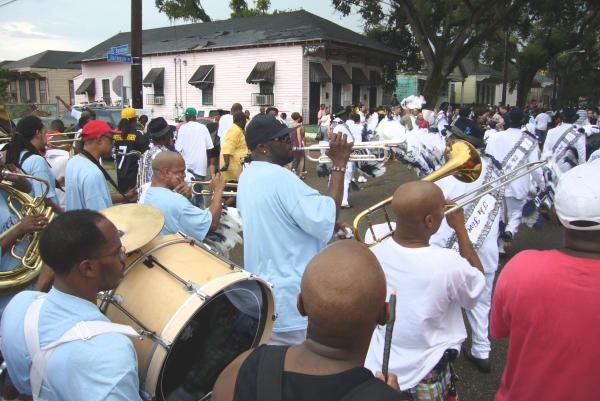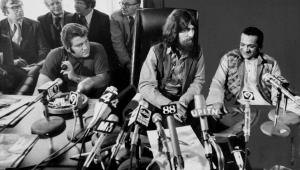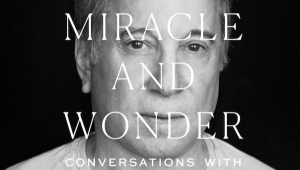New Orleans Culture at a Tipping point Part 4
Considering a Motion to Demolish Four Public-housing Projects
In the meantime, you do remember that City Council councilman-at-large seat left vacant by the dishonored Oliver Thomas, don't you?
Well, it's filled in an open election by a former City Councilwoman, Jacquelyn Brechtel Clarkson, Jackie to her friends and constituents—a prominent real estate agent, community presence, and about as old-line as old-line gets (not to mention the mother of indy-throb actress Patricia Clarkson ' and you though New Orleans politics was never any fun!).
And then, no sooner than Jackie Clarkson's election creates the first white majority on the New Orleans City Council in 30 years, along comes a controversial resolution before the Council calling for the wholesale destruction of four of the city's oldest and most-firmly-established public-housing projects.
Each one of these major architectural landmarks spread throughout the neighborhoods of the city's working-class African-American community had been built pre-1960s as a spacious, state-of-the-art, garden-apartment complex containing several red-brick structures, each two and three stories high, complete with wrap-around porches, wrought-iron railings, and well-tended gardens.
The City Council resolution, in fact, simply represented the legal conclusion of a process begun more than year before when the federal department of Housing and Urban Development announced its intention to accept bids for redeveloping the land these aging-but-sturdy housing projects presently occupied.
And, actually, the city had been down this same road before. In the years just before Katrina, contractors hired by the city demolished the entire St. Thomas housing project— previously home ground to rapper-cum-music mogul Master P, a/k/a Percy Miller—and replaced it with a new, federally endorsed housing development intended to replace inner-city projects with market-rate housing financed through shared public-private investment.
Formally titled Hope VI and actively promoted by HUD since at least the middle of the Clinton Administration, the ultimate goal behind encouraging these 'New Urbanism'-inspired public-private partnerships was to help alleviate a multiplicity of problems uniformly associated with high concentrations of poverty.
The only problem, according to Bill Quigley, a public-housing advocate and professor of law at New Orleans' Loyola University, is that these public-private 'partnerships,' generally turn out to be something more like 'a developer's dream and a resident's nightmare.'
That was definitely the case with New Orleans' River Garden development (such a pretty name!), installed directly on top of the recently turned graves of those nasty, old St. Thomas 'projects.'
First, said developer Historic Restorations, Inc., the new digs would absolutely be financially unfeasible without added, long-term income generated by a specially directed tax district established within the boundaries of the development and attached specifically to the installation of the very first Wal-Mart store to be built within an inner-city context.
Imagine the screaming from preservationists and housing activists alike—which resulted in a Wal-Mart 'compromise': scaled-down visual impact, brick on the outside walls, and less obnoxious signage all around.
And never mind the outrageous irony of a federally supported redevelopment effort supposedly designed to help eradicate inner-city poverty encouraging a vanguard assault on the urban poor by a discount chain that's become wildly successful by feeding parasitically on the rural poor.
And then it turned out, of the 1,500 apartments previously contained within the demolished St. Thomas public-housing project, developers eventually admitted they would not be able to deliver quite as much low-income housing as they said they could—initially advertised as a one-third replacement rate for apartments being demolished—but would be building only 120 low-income units.
And did I mention that the New Urbanist, post-modern architecture intended for the new development, designed to precisely mimic classic New Orleans styles, would ultimately result in street after street with a look and feel—due largely to their overall gaiety and universally sharp architectural lines—more like the picture-perfect Seaside vacation development in coastal Florida than the worn-down, old-shoe-feeling urban neighborhoods that extend for blocks surrounding them?
A Unanimous City Council Vote Heard 'Round the World
In opposition to the June, 2006 announcement by HUD of its intention to tear down those four New Orleans public-housing projects, activists sponsored marches, held rallies, filed a federal law suit, and even managed to attract enough attention to warrant local and federal legislative hearings.
Meanwhile, preservationists and social activists alike argued that the squat, brick barracks scheduled for demolition—comprising 5,000 units total and representing roughly 70 percent of the city's remaining public-housing stock—remained architecturally sound in the wake of Katrina flooding and represented a prime opportunity to house still-displaced residents.
And this in a housing environment where the flooding that followed Hurricane Katrina had destroyed a total of nearly 150,000 apartments, adding to scarcity housing created by the destruction of another 150,000 homes and driving up the metropolitan area's median rent by an estimated 60 percent.
So, when it came time for the New Orleans City Council to vote on a resolution to demolish, which could provide a meaningful veto opportunity in support of preservation, optimists had some cause to believe that reason might yet prevail.
Another good sign, they thought: the vote itself was scheduled the week before Christmas. Who wanted to be seen as denying much-need public housing for badly suffering poor folks in the middle of the Christmas holiday season?
But maybe you know how this story ends. The new white-majority City Council voted unanimously to approve demolition.
Incensed activists in the audience were arrested, sensational video footage was shown on CNN and other news channels all around the world, and liberal media outlets could hardly barely believe what had just gone down. But more-careful observers might not have been so surprised.
In a way, this was just the new City Council majority announcing its presence, devising its own special way of saying, 'Welcome to the New New Orleans!' And have yourself a Happy New Year!
But all was not completely lost. New Orleans could at least claim to be in the forefront of a national movement, as public-housing advocate Bill Quigley, cynically pointed out after the vote.
'Katrina gave government the opportunity to fast-forward (in New Orleans) what other communities are going through,' Quigley told reporters, 'In terms of the conversion of traditional public housing, (which will bring with it the subsequent) displacement of hundreds of thousands of families.'
HUD Secretary, FBI Agent-in-charge Make Their Hasty Exits
The vote to demolish and the events surrounding it were so traumatic that most observers paid scant attention to the series of events that followed, each resounding with its own unique mix of cynicism, irony, and folly.
First, the city's Ernest C. Morial Convention Center authority tried to slip a logo redesign past everybody during the egg nog-saturated week between Christmas and New Year's. Just freshening the graphics, sharpening the identity, more-aggressively positioning the facility, they said.
But every picture tells a story, don't it? Somehow, in the course of the graphics facelift, the place was effectively renamed the New Orleans Convention Center, with homage to Ernest C. Morial, the city's first black mayor, reduced to typescript the size of fly tracks. No one said a word, but everyone I spoke to in New Orleans' black community had noticed. And then the Morial family weighed in with a strong letter of outrage that was reprinted on the Times-Picayune's front page.
Next, Alphonso Jackson—the driving force behind the demolition of the four major New Orleans' public-housing projects—resigned as HUD secretary after four years in office amid a flurry of allegations that included awarding contracts based on Republican political affiliation, personally profiting from the award of a $127 million redevelopment contract in New Orleans, and interceding on several occasions to benefit friends and prot'g's.
Finally, James Bernazzani, the FBI agent spearheading corruption investigations in post-Katrina New Orleans, officially announced, during a local TV interview, that he was seriously considering entering the race for New Orleans mayor when Ray Nagin's second term expires in 2010.
There were two things wrong with this. First, as an FBI agent, you are not allowed to get personally involved in electoral politics of any kind. And, second, Bernazzani was the man most responsible for putting the leading candidate for mayor, former city councilman Oliver Thomas, in jail on corruption charges that seemed marginal and paltry at best. (The kingpin of a scheme to skim one million-plus dollars from city contracts said he gave Thomas $17,000 almost a decade before to insure a city parking contract).
Bernazzani was immediately asked to resign as well, but no one suggested the FBI look into his investigation and subsequent sentencing recommendations for Thomas, especially in light the agent's now-admitted political aspirations.
Oh, and one other thing—backhoes began digging up the foundations, toppling the walls, and breaking apart the roofs of those four public housing projects.
'They Really Have No Idea What They're Talking About'
While much of the world and most of the city has remained oblivious to the essential plot line taking shape, it wouldn't be fair to say that no one has noticed, or called attention to, what has been going on in post-Katrina New Orleans.
Less than a year after Katrina struck, U.S. Representative Barney Frank (D-MA), chairman of the House Financial Services Committee, weighed in to comment on the obvious racial transformation of America's most 'Afrocentric' city.
'In a calculated way,' Frank told reporters, 'you refuse to do anything for well over a year after the disaster, (and) the policy, I think, is ethnic cleansing by inaction.'
When challenged on those remarks, Frank refused back down, insisting he had rejected the more serious charge of 'genocide,' and had, in fact, chosen his terms precisely.
Frank objected again just this summer when the U.S. Senate hijacked a House bill calling for subsidies of approximately $500 million a year for low-income housing.
Instead of directing funds specifically to New Orleans in the program's inaugural year, as Frank and the bill's sponsors had planned, the Senate changed the bill to make funds available nationally, before sending it off for the President's signature.
And writing not long after the HUD announcement, The New York Times' architecture critic called for a sobering historical perspective.
'The rebuilding of New Orleans,' Nicolai Ourousoff told the Times' readers, 'is emerging as one of the most aggressive works of social engineering in America since the postwar boom of the 1950s. And architecture and urban planning have become critical tools in shaping that new order.'
And then, just this past spring, there was the United Nations.
First, a couple of unpaid observers issued a statement asking the city to wait on tearing down its much-beleaguered housing projects. Sometime later, a U.N. committee issued a report that prominently took note of the city's failure to restore housing in black neighborhoods, based in part on conclusions provided by the same two analysts.
'The committee remains concerned,' the report stated in the most careful terms possible, 'about the disparate impact that this natural disaster continues to have on low-income African-American residents, many of whom continue to be displaced more than two years after the hurricane.'
The very next day, New Orleans' newspaper of record, the Times-Picayune, published its impassioned and defiant response. 'There's no nice way to say this,' the paper's lead editorial began, '(but) the assessment of New Orleans public housing by two United Nations analysts is a sham.'
That sham, the editorial went on to say, consisted of unsubstantiated charges that public-housing demolition would not only ignore residents' wishes, it would leave a significant void in the city's post-disaster planning process, and further serve to do nothing promote already rampant poverty and homelessness in the city.
Pointing out that the analysts had reached these conclusions without once actually visiting New Orleans, the city's dominant media outlet—still managed by the monied elite and reduced now to mostly consumer boosterism—haughtily concluded: '(T)hey really have no idea what they're talking about.'
Without straining too far, of course, the casual observer could easily hear in this retort the echoes of the pre-Civil Rights South, when racist Dixiecrats blamed all those 'outside agitators' for stirring up trouble amidst a black population that Southern whites claimed was more-than-happy with the status quo.
'They don't know our blacks the way we do,' was the prevailing sentiment expressed by all those despicable Southern segregationists back in the day. 'They should just go back to wherever they came from, and mind their own business. They really have no idea what they're talking about.'
A Final Ultimatum, Delivered by the Uptown Elite
You may not be aware of it or even believe it but there is, in fact, a ruling elite in New Orleans—an intact, plantation-era contingent of the powerful and wealthy—that not only sponsors Mardi Gras parades and debutante balls, but also runs many of the city's banks, law firms, and businesses, meanwhile sitting on the boards of a whole range of non-profits (or 'charities,' as they're still thought of here).
While it may be true that nearly every well-established city of any size in America has its own economic and cultural elite, New Orleans differs in the extent to which this segment of society remains apart from but actually influences daily life.
Or influenced, to be more precise.
In the wake of 1960s civil rights legislation and related white flight to the suburbs, New Orleans changed more rapidly and more dramatically than most American cities, with a reversal of power that left the city's monied elite stranded in an urban environment they still thought of as their own, but no longer controlled. And every slight since then, the transgressions of every mayoral administration, has registered with a vengeance.
A high-water mark was reached in the early 1990s when a black woman on the black-majority city council introduced an ordinance to force the city's most-private and most-elite Old South clubs, sponsors of the city's oldest and most traditional Mardi Gras parades, to open their membership to the public.
Refusing to comply, three of the four oldest Mardi Gras organizations simply refused to parade, closing up shop and retreating to their private balls. But that didn't mean they weren't still fuming. Quietly. Politely.
Understanding this perspective helps make sense of a front-page article that ran in the September 8, 2005 edition of The Wall Street Journal, ten days after Katrina struck.
The national paper of record for the monied set reported that 40 card-carrying members of New Orleans' business and social elite insisted on an emergency meeting with Mayor Ray Nagin in Dallas, where he maintains a second residence.
Describing with suitably prurient precision a backdrop of Israeli commandoes helicoptering in to protect Uptown mansions and privileged residents sipping highballs in their driveways to cool off in the post-disaster evenings, The Wall Street Journal sketched in details of the meeting and its participants.
But the gist of the affair was contained in a single quote from a prominent leader. 'Those who want to see this city rebuilt want to see it done in a completely different way, demographically, geographically, and politically,' he reportedly insisted. 'The way we've been living is not going to happen again. 'Or we're out.'
But to fully comprehend the political dynamics at play in post-Katrina New Orleans and to better understand how a dramatic political and social transformation could be taking place there that may mean the extinction of centuries-old cultural traditions, we really need to look at three other population components, each motivated in its turn by resentment, by complacency, and by naivet'.
The coalition of conservatives across the socio-economic spectrum from moneyed and educated to everyday working folks, for example, may share the fervent resentments of the aristocratic elite even while they're motivated by a slightly different set of concerns.
We can get a pretty good sense of what they're feeling from a post-Katrina eulogy published in the September 2007 issue of Commentary, a New York City neoconservative journal, by Ben Toledano, a New Orleans attorney who ran for mayor unsuccessfully in 1970 and has since renounced all affection for his old hometown.
Toledano's mayoral campaign coincided neatly with the white flight of the post-Civil-Rights-era whites that finally gave blacks a ruling majority (which they'd also had in the decades preceding the Civil War). The resentment he felt at being squeezed out of the political equation back then is pretty clear in the comment he attributes to an anonymous member of the 'new black-power elites.'
'It's our turn now, baby,' Toledano reports being told, 'You guys have been at the trough since the beginning. (Now it's your turn to) move over, all the way over ' Whatever's left belongs to us.'
Toledano's conclusion? 'Reports of the death of New Orleans have not been greatly exaggerated; they have only been greatly delayed.'
Laying the blame on a strictly hierarchal social structure installed by aristocratic whites, reinforced by New Orleans' typically Caribbean Creole strata, and imitated with a vengeance by a black political majority that took power in the 1970s, Toledano's analysis carries with it a subtext heard frequently throughout the city before Katrina, but expressed today with far greater urgency.
Toledano's subtext is this: for more than three decades, a black majority has ruled New Orleans and by almost any measure, the city has been in sharp decline for all that time. Poverty and crime have only increased, government corruption has become endemic, federal officials were forced upon the city's public housing authority and state officials have taken over the incredibly corrupt and incompetent school system. In short, black folks had their chance and now they've left it to us good white folks to clean up their mess.
At the lower socio-economic end of the spectrum, there is also a barely concealed strain of blatant racism that most educated folks in other parts of the country would rather not acknowledge, and probably prefer to believe no longer exists. But it does.
And it helps explain a long series of events associated with the Crescent City in the second half of the 20th century, from the ugly and virulent resistance in 1960 to court-ordered elementary school integration—vividly depicted in John Steinbeck's 'Travels with Charley' (Viking, 1962) —to the nearly viable 1991 gubernatorial campaign of David Duke, Grand Wizard of the Ku Klux Klan.
Most recently, that nasty and unacknowledged brand of indigenous racism reared its ugly little head not long after this year's Jazz & Heritage Festival to burn the letters KKK in the lawn of a suburban black family, while a successful campaign in the beginning of the summer to formally oppose the incorporation of a town on 'the other side of the tracks' in rural Louisiana near New Orleans spread its message with printed signs that bluntly read: 'Vote No on Nigger Town.'
Gooning and Gushing at the Mardi Gras Ball
You can get a clear sense of just how mind-crushingly conventional the city really is by tuning in on Friday evenings to back-to-back local panel discussions on the city's PBS station, one covering timely news topics and the other culture and the arts.
The producer of the first show is Errol Laborde, a standing panel member and long-time editor of the city's upscale monthly magazine, while the producer and host of the second show is his wife, Peggy Scott Laborde, a documentary maker with a seemingly insatiable hunger for elegies on the 'lost' New Orleans of the recent past.
Their personalities really tell you all you need to know—he's unfailingly dour and lacking any dimension of humor or imagination, while she's infinitely cheery and exquisitely careful to avoid even the slight hint of a controversy—but to get the full picture, you really need to see them broadcasting together on Mardi Gras night.
Dressed in their finest formalry, replete with white ballroom gloves for monsieur, they purport to 'cover' the tableaux balls of Rex—the public face of white New Orleans aristocracy and Comus, its exclusive, private face—all the while gooning and gushing like a pair of farm-country teenagers with their noses pressed up against the window of a big, bright mansion in the great, storied city.
The city's political, business, cultural, and social establishments, a component of the population that includes everyone from City Council members and the directors of local cultural institutions to nearly all local journalists, represents a kind of 'silent majority' motivated primarily by self-interest, and the self-interest of others they recognize as being like themselves.
In the Second Reconstruction of New Orleans, they have clearly established themselves as passive, but apparently willing participants in the consequent social and cultural transformation that would naturally be implied in any major city by removing roughly half of a majority black population from the city's voting base.
Finally, there is a significant segment of the post-Katrina New Orleans population that would naturally appear to be opposed to something as inherently unjust as the exclusion of a large portion of the city's African-American community, but, like a lot of folks these days, they just aren't quite aware enough, or able to fully grasp the implications of what is happening, or have learned enough about social activism, despite the shine of good intentions attached to all their best efforts.
You could call them The Na've Generation, because they are mostly young or youngish (but not exclusively—obliviousness these days knows no age barriers) and their ranks include an extremely wide range of do-gooders who haven't really taken the time or the trouble to understand either what the problem really is or how it might actually be solved.
In post-Katrina New Orleans, this social category embraces a large contingent of the newly arrived and those awakened to social change as well as a large, resident contingent of 'true believers,' who must, as a requirement of membership, accept as a given the city's uniqueness, have faith in its ability to survive any kind of political or social trauma, and unquestionably imagine its ultimately emerging from this period of post-Katrina rebuilding unscathed.
Locally, this constituency has most audibly expressed itself by embracing the hope for and the belief in a 'return to normal.'
Celebrity Benefits and Misguided Profits
Add to that population base a wave of social activists who believe that simply expressing dissent will dramatically change society, celebrities who believe that sharing the spotlight will actually make all of us better people, and independent souls living on the cultural margins who believe their own marginality is a social statement all it own, requiring no follow-through or further explanation.
You remember all those star-studded 'benefit' concerts and CDs, don't you, that came pouring out even while Katrina's floodwaters remained deep-soaking the city? Any idea where the money went or what the ultimate results were?
What about that Habitat for Humanity project we keep hearing so much about, or Brad Pitt's super-cool initiative in the Ninth Ward? Any idea how many houses we're talking about building versus how many houses have been destroyed?
For all the publicity generated by these 'helping New Orleans' projects, the truth is, three years after the disaster, it's still virtually impossible to see any real evidence of significant improvement anywhere on the ground—except for a new travel category historians one day may trace back to past-Katrina New Orleans that has come to be called 'voluntourism.'
And the same goes for the work of local nonprofits. You may not know it, but the New Orleans Jazz & Heritage Festival Presented by Shell is actually 'owned' by a nonprofit set up from the very beginning expressly for that purpose, the New Orleans Jazz & Heritage Foundation.
The Foundation staff will even list for you the 20 or so projects they currently fund, and show you a bunch of newspaper features on how much good these programs do.
What they won't tell you is that, no matter how much the festival costs to produce—$5 million, $10 million, $20 million, $30 million, $40 million—public tax records show the foundation never makes more than $100,000 to $150,000.
Where'd all the money go? The Foundation contracts with a private production firm to actually put on the festival, so the actual financing of the festival remains a mystery, but you start adding up headliner's fees, year-round staff salaries, advertising, construction, etc., etc.
And then, of course, there's the Foundation itself, with its own set of year-round staff salaries and a massive board of directors who named themselves members-for-life in the mid-1990s.
And the rare local groups who actually do make a real difference—a musicians' clinic set up before Katrina, for example, or a social service outreach effort established by Preservation Hall after the storm—have fallen prey to the same logical fallacy that plagues most of American 'independent' culture these days.
The mistaken indy mantra is this: If we stay small and just do what we do while avoiding mainstream engagement, we can be more effective.
Anyone know of a single political or social reform movement, never mind artistic movement, made more effective by remaining unseen and the unheard?
'The First and Now the Last Pocket of American Singularity and Soul'
In practical terms, reacting to the idea that a culture may be threatened with extinction by ignoring it or dismissing the idea out of hand, is actually a response that's entirely understandable.
The long-term survival of cultural depends mainly on two sources of support. One is the enthusiasts who value, participate in and promote whatever cultural experience holds great meaning to them, and the other is active agents in the world of commerce, where culture is sponsored, packaged, promoted, and profited from. And neither of these universes, with rare exceptions, encourages any kind of critical or, dare we say it, negative thinking.
But the lack of attention on all sides directed toward the threatened roots of New Orleans musical culture in the wake of Hurricane Katrina is understandable, too, because the actual demise of culture may be striking an even deeper chord in the human psyche.
One way of thinking about this, in basic terms, is simply to say that we don't like to think about the ending of things, especially while we are in the midst of enjoying them.
But on a deeper level, the Swiss psychiatrist Elisabeth K'bler-Ross, author of the modern text on endings and loss, 'On Death and Dying,' has pointed out that, while each of us has been thankfully blessed with extraordinary powers of both observation and reason, the instinct for survival in us is so undeniably strong that we remain practically incapable of imagining our own death.
And in New Orleans, the deeply rooted nature of local tradition combined with the especially resilient character of the local population has unquestionably convinced the vast majority of enthusiasts that New Orleans culture is probably invulnerable.
Serious fans, for example, point out the continued ability of the local culture to produce musical riches, beginning with the first French opera house in American in the early 19th century and running a gamut in the 20th century alone from the birth of jazz to early R&B to sumptuous funk and even Dirty South rap and hip hop.
Casual fans, for their part, hear something like traditional New Orleans jazz played in a contemporary New Orleans setting that emphasizes the music's heritage--the Preservation Hall performance space in the French Quarter, for instance--and immediately jump to the conclusion that jazz began 100 years ago in that location and continues to be played there.
While it's certainly true the genealogy of New Orleans' music traditions can be traced back into the past along an unbroken line for at least 100 years--in actuality, something more like 250 years--in the 20th century there have been two notable instances when those traditions flirted with extinction, only to be rescued by bands of zealous enthusiasts and the presence of a favorable commercial climate.
In the first instance, an out-migration of population and musicians during the Jazz Age gradually combined with the subsequently withering effects of the Great Depression of the 1930s to produce a music scene so paltry that a city guide produced in 1937 by the federal government's Works Progress Administration could find no evidence of 'genuine negro jazz bands.'
Before long, though, a growing subculture of obscure jazz record collectors in big cities on both U.S. coasts came to New Orleans in search of surviving Jazz Age pioneers, thereby setting off a musical 'reformation'--generally known as The Traditional New Orleans Jazz Revival--that not only changed the make-up of popular music forever, and led to the early 1960s founding of Preservation Hall, but is still being felt today.
Four decades later, the hyper-commercialized transition to an entertainment 'blockbuster' mentality, musically represented by the Age of Disco, rendered nearly mute a vibrant music scene that had since the early 1950s exported an amazing amount of early R&B before almost single-handedly defining the late-1960s transition to instrument-laden funk.
Visiting New Orleans in 1974, for example, producer and record-company executive Joe McEwen reported on finding such a lack of live venues and other outlets for locally produced New Orleans music that 'the place seemed oddly stagnant ' The torch was almost extinguished.'
But sixteen years later, when McEwen contributed liner notes for the second of four masterful Columbia albums by The Dirty Dozen Brass Band, things had changed dramatically. 'New Orleans has again sprouted full bloom,' McEwen announced, describing the revived music scene as 'the first, and now the last, pocket of American singularity and soul.'
End of Part 4

















































